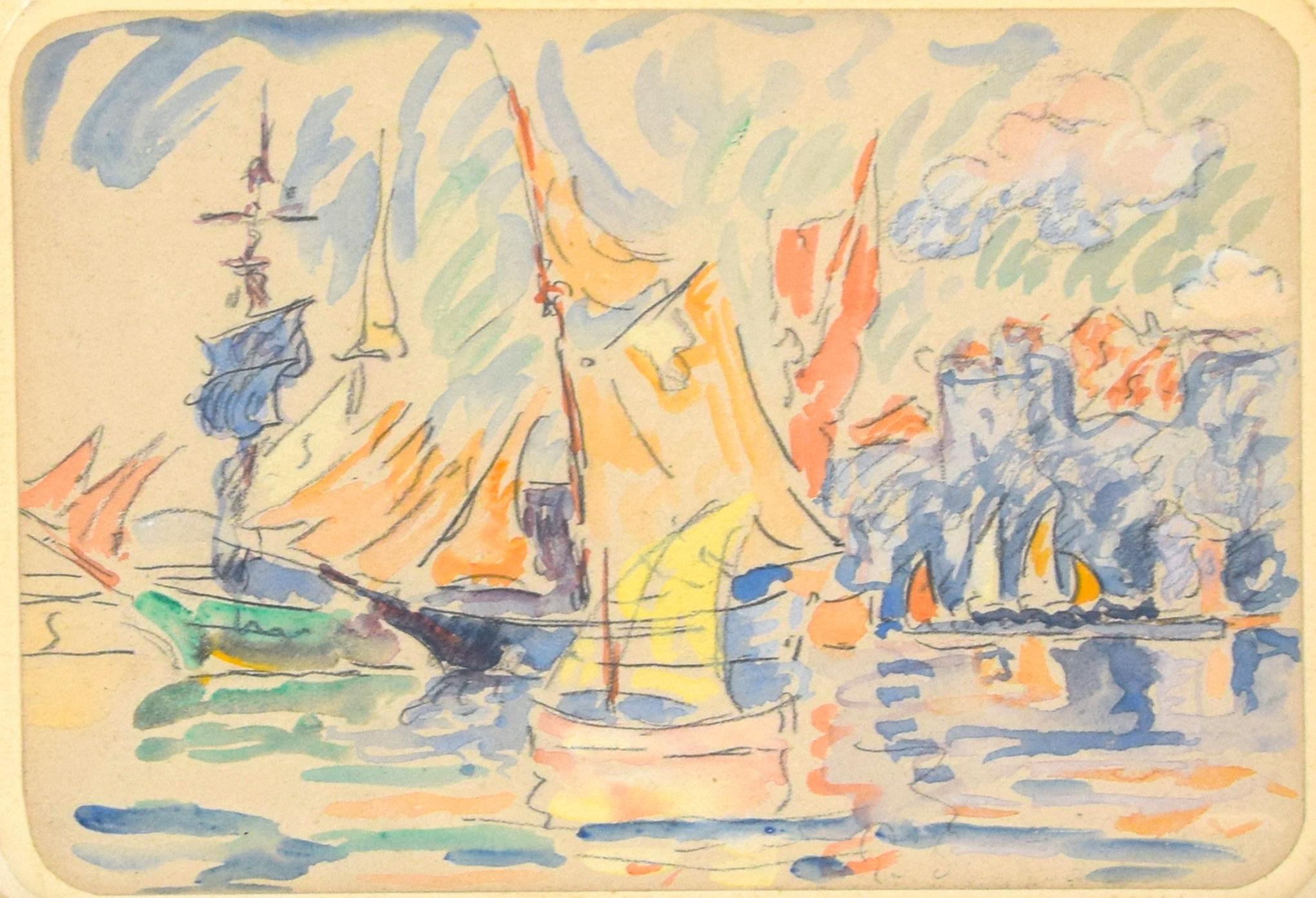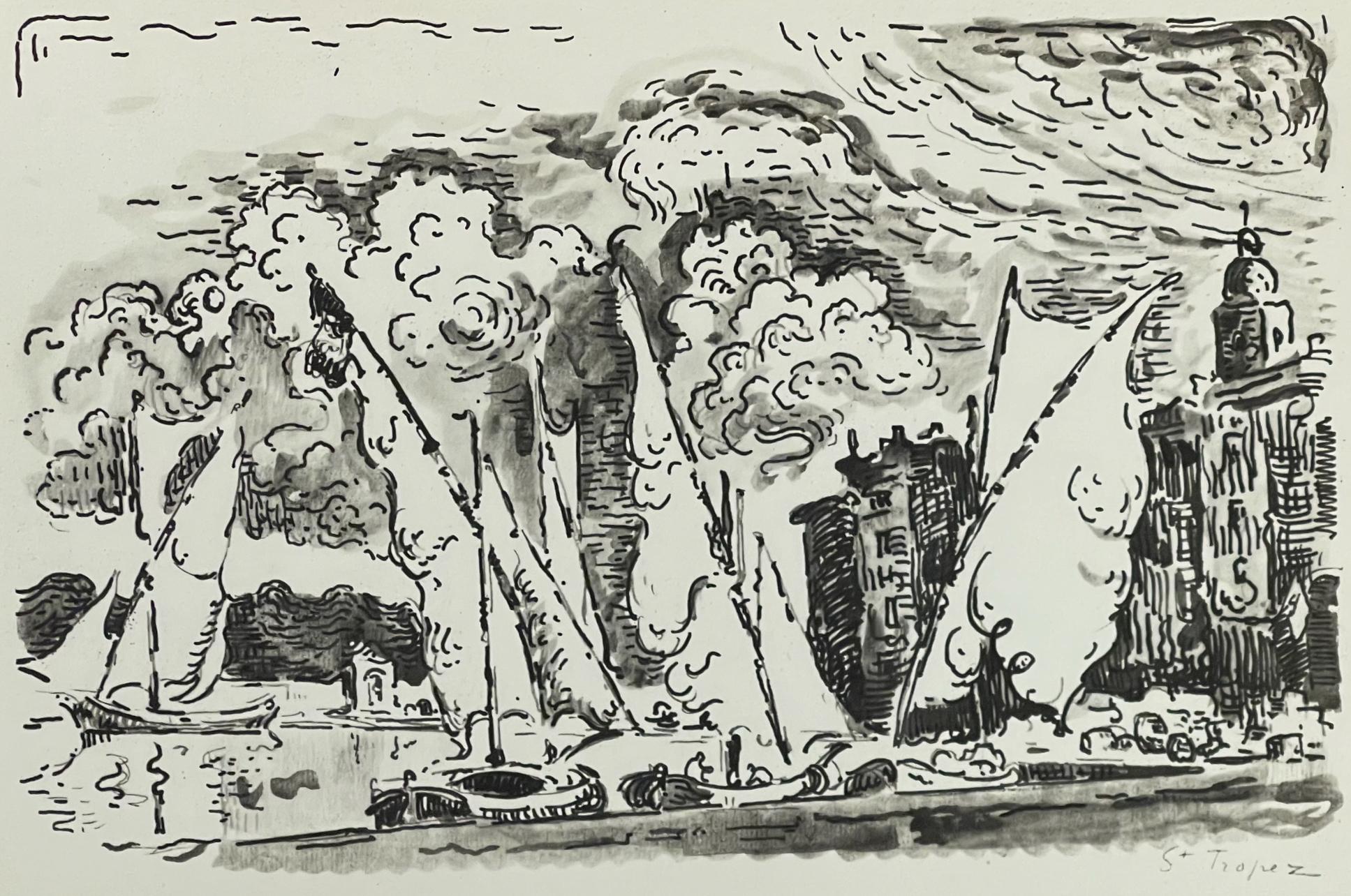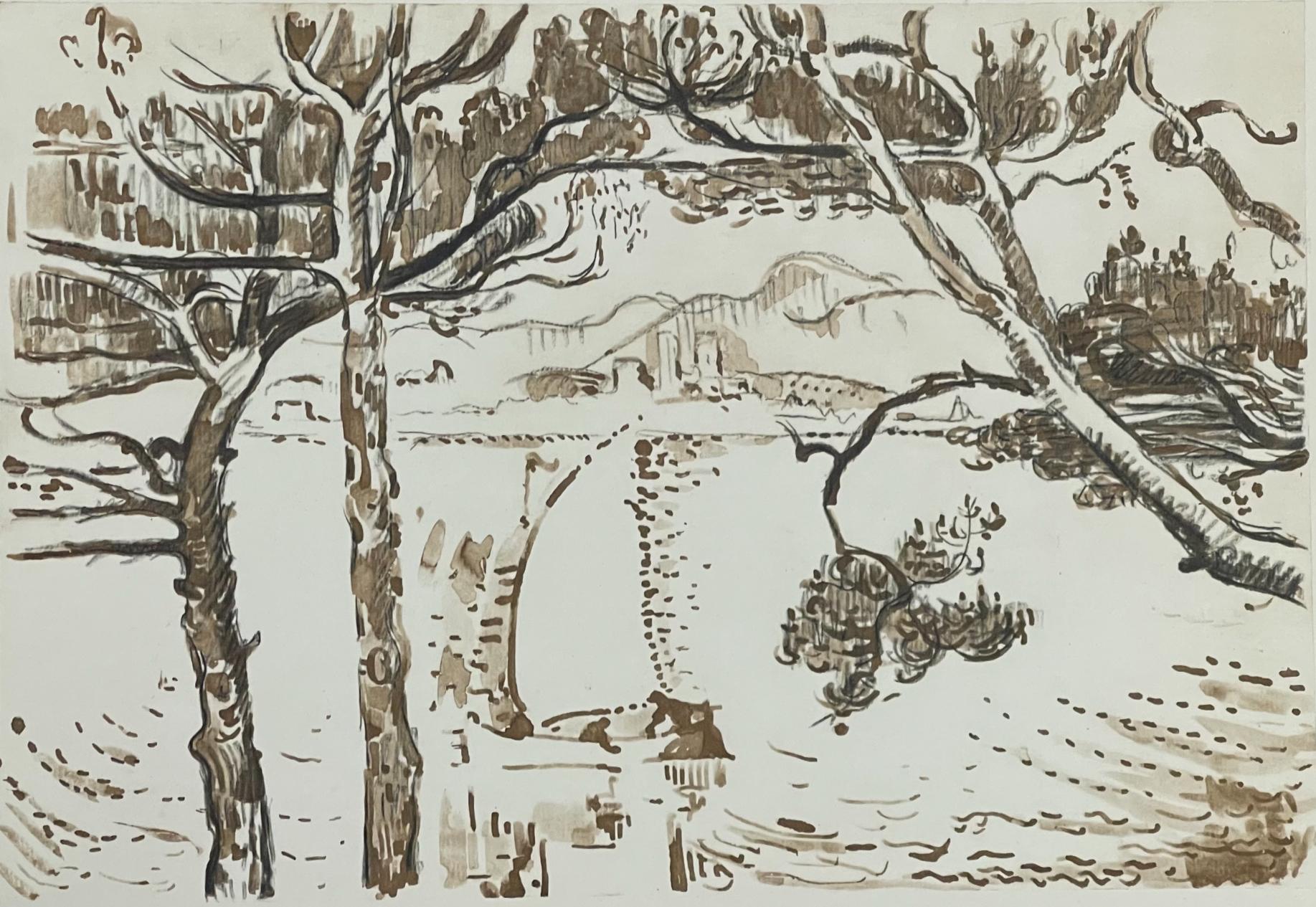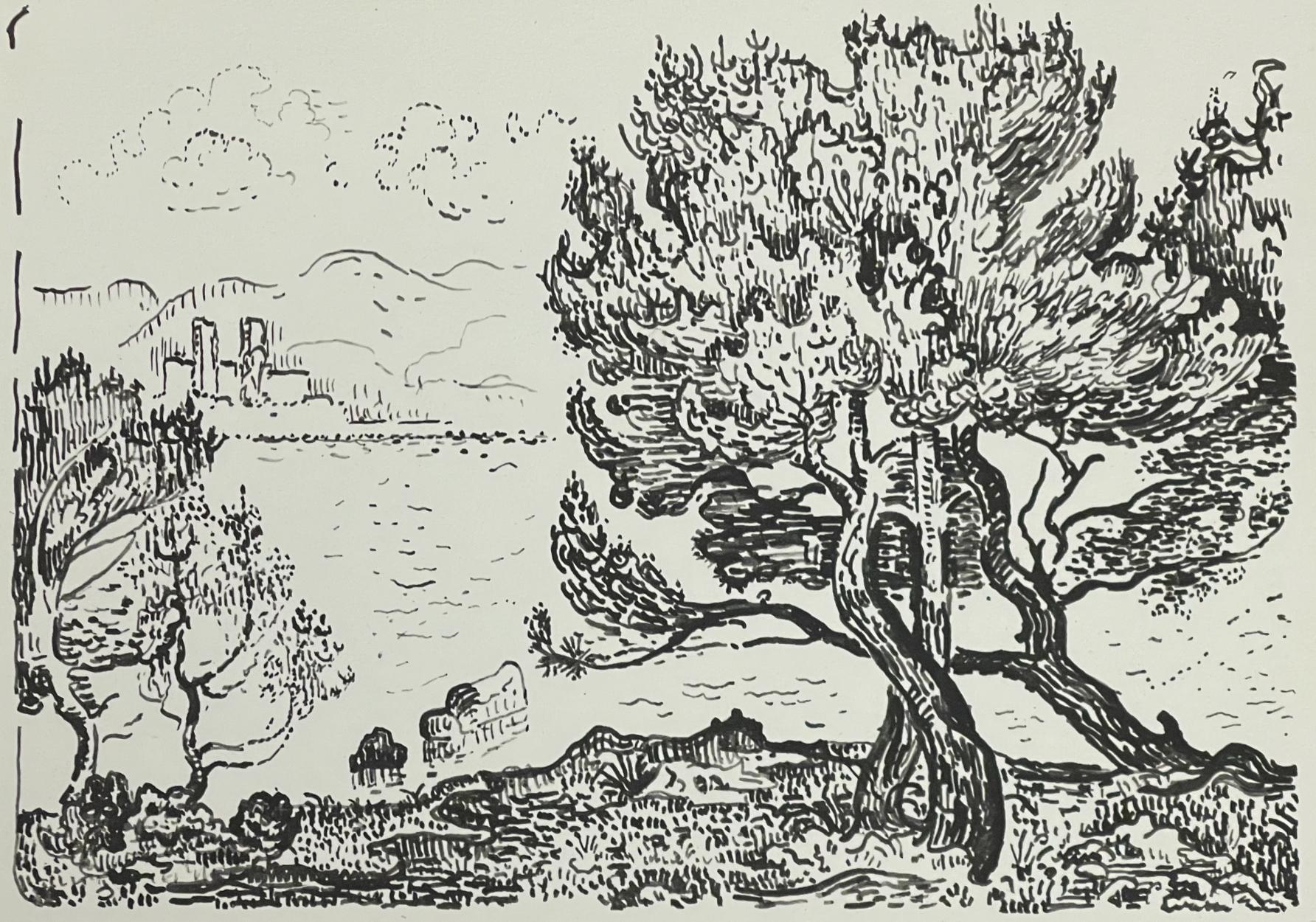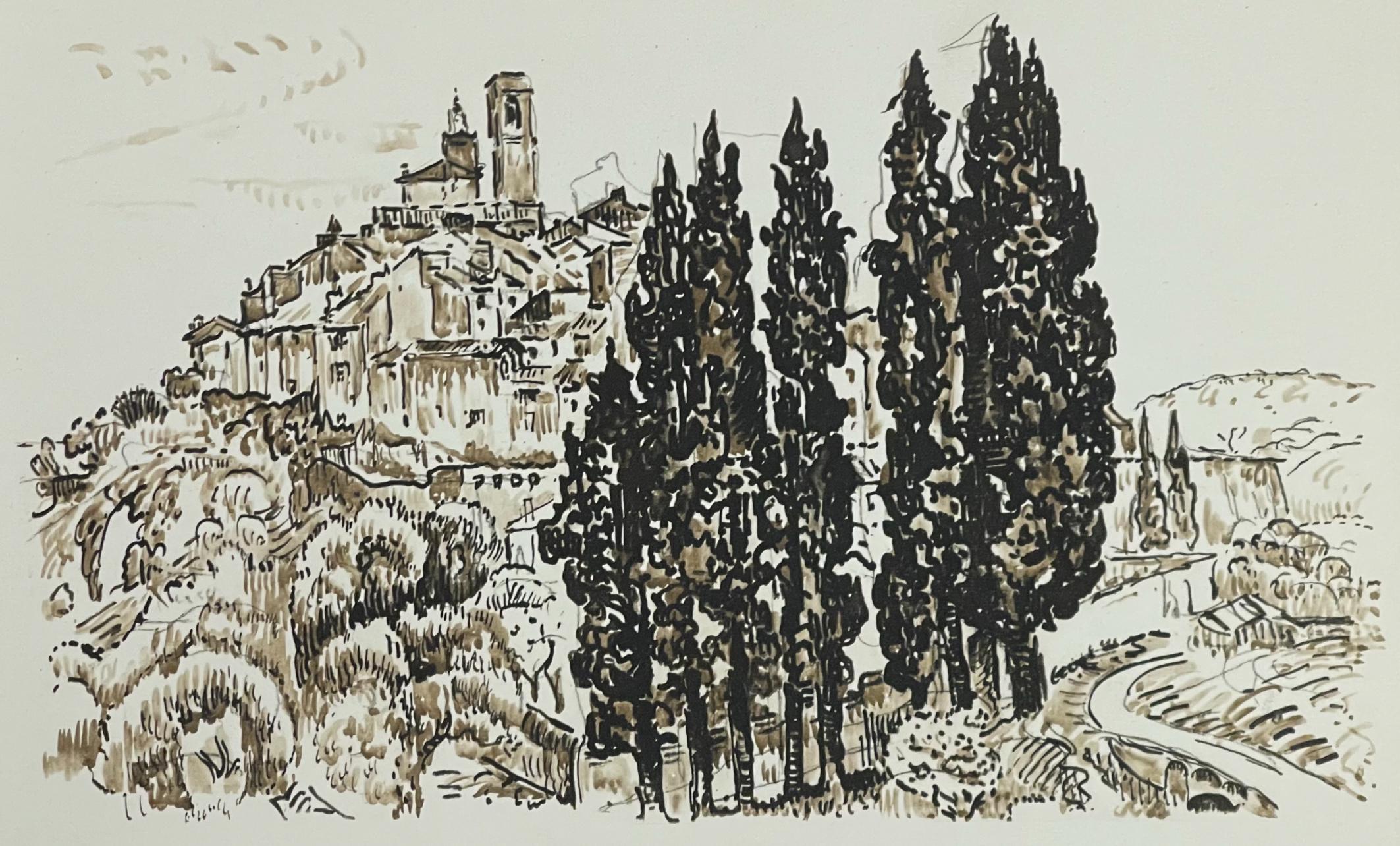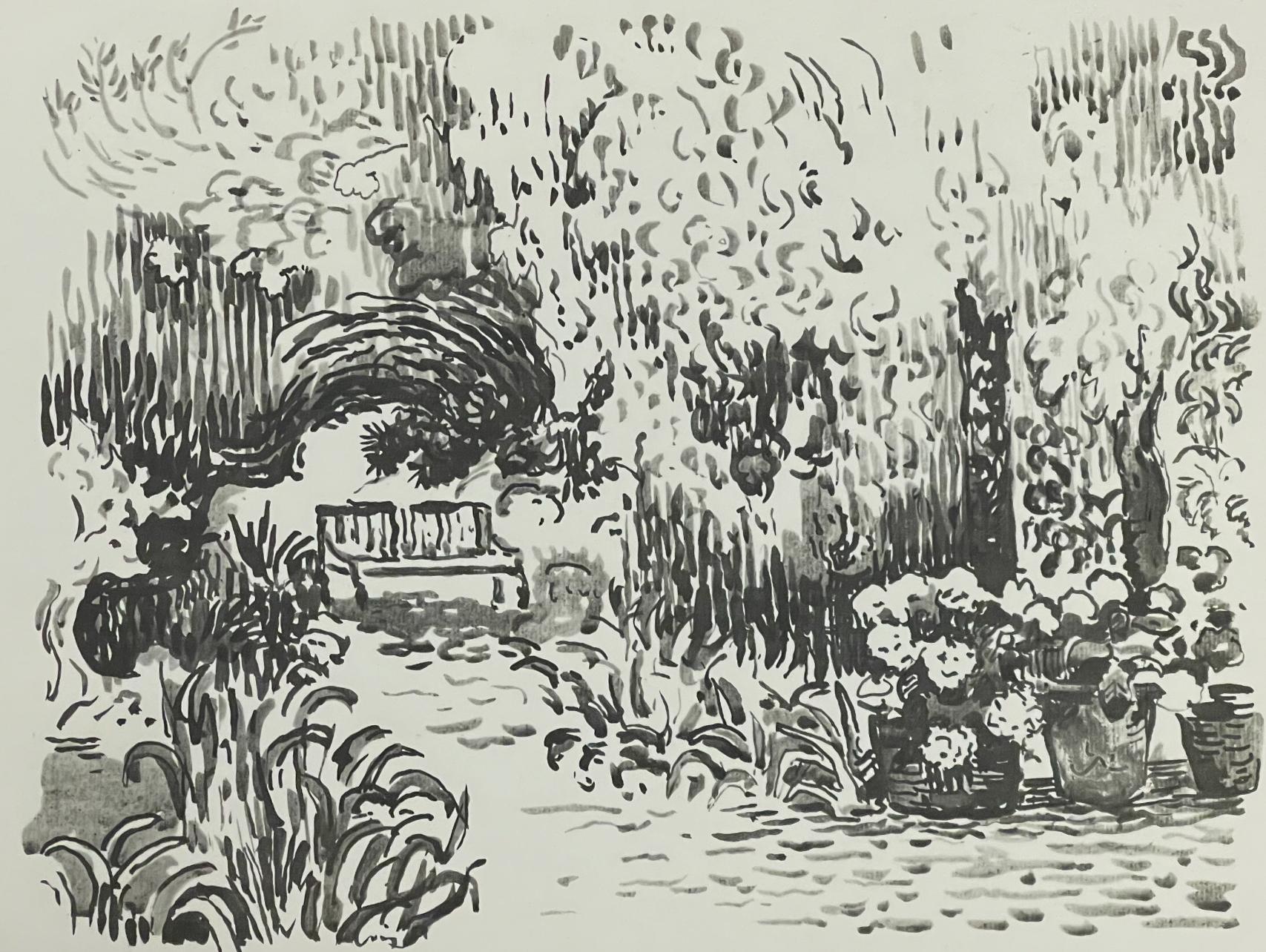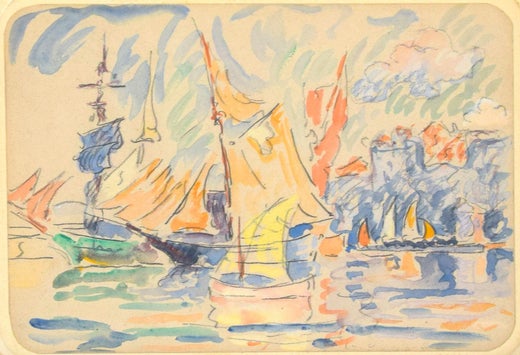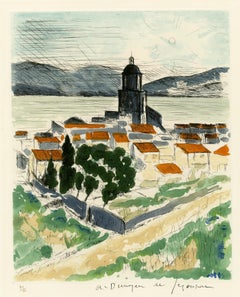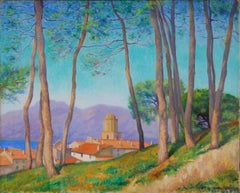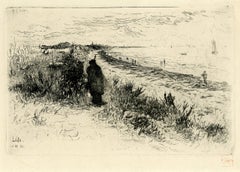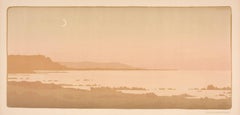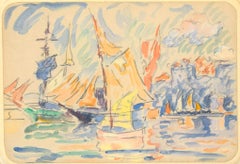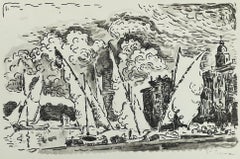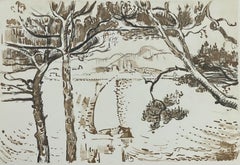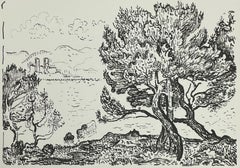Items Similar to Saint-Tropez-Le Port
Want more images or videos?
Request additional images or videos from the seller
1 of 11
Paul SignacSaint-Tropez-Le Port1897
1897
$25,000
£19,054.03
€21,779.98
CA$35,173.43
A$38,531.39
CHF 20,281.43
MX$459,882.30
NOK 258,536.85
SEK 236,341.65
DKK 162,692.55
About the Item
Saint-Tropez-Le Port
Color lithograph, 1897-1898
Signed in pencil lower right (see photo)
Numbered in pencil lower right: No. 68 (see photo)
From: Album des Peintres-Gravures, 1898
Published by Ambrose Vollard, Paris
Printer: Auguste Clot, Paris
Edition: 100
Numbered: No. 68
Reference: Una Johnson, Vollard, No. 188, reproduced plate 35
Kornfeld & Wick, No. 19 b/b
Condition: Very fresh unfaded colors colors
One tiny spot in the upper margin above the image (see photo)
Framed with Tru Vue Museum Glass
Image size: 17 1/8 x 13 inches
Frame size: 32 3/4 x 27 1/4 inches
Archival framing by Galerie Maximilian, Aspen, CO
Museum glass
22K Gold leaf hand carved frame
The artist's most famous print. Illustrated in Adhemar and Johnson
Impressions can be found in the following museums:
Metropolitan Museum of Art
National Gallery of Art, Washington
Philadelphia Museum of Art
McNay Art Museum, San Antonio
Clark Institute, Williamstown, MA
Saint Louis Art Museum
National Gallery of Victoria
High Art Museum, Atlanta
Nelson Atkins Museum of Art, Kansas City, MO
National Gallery of Canada
Museum of Modern Art, New York
Cleveland Museum of Art
Cincinnati Art Museum
"Paul Signac depicted the old port of St. Tropez, in southern France, from the harbor. The scene glistens in an effect achieved with small dots of unmixed color and, significantly, the white of the paper. The tower of the village church, Nôtre-Dame-de-l’Assomption, rises in the background amid clouds that are made only of the paper itself.
The artist was among the most articulate proponents of the movement now known as Neo-Impressionism, in which color was applied to canvas or paper in small, individual units. It is the role of the viewer’s eye and brain, rather than the painter with his brush, to complete the blending of the hues. Signac drew the image on specially prepared transfer paper, which the printer would have transferred to a series of stones, one for each color." Courtesy Saint Louis Art Museum
- Creator:Paul Signac (1863-1935, French)
- Creation Year:1897
- Dimensions:Height: 17.13 in (43.52 cm)Width: 13 in (33.02 cm)
- Medium:
- Movement & Style:
- Period:
- Condition:
- Gallery Location:Fairlawn, OH
- Reference Number:Seller: FA123541stDibs: LU14015736762
Paul Signac
also known as: Paul Victor Jules Signac He was a French Neo-Impressionist painter who, with Georges Seurat, helped develop the artistic technique Pointillism. The Mediterranean coast is a central theme across Signac's paintings. He purchased a house in the south of France in the village of Collioure or at St. Tropez where is invited his friends to visit.
Signac loved sailing and began to travel in 1892, sailing a small boat to almost all the ports of France.
As president of the Société des Artistes Indépendants, from 1908 until his death, Signac encouraged younger artists by exhibiting the controversial works of the Fauves and the Cubists. He was the first patron to buy a painting by Matisse.
About the Seller
5.0
Recognized Seller
These prestigious sellers are industry leaders and represent the highest echelon for item quality and design.
Gold Seller
Premium sellers maintaining a 4.3+ rating and 24-hour response times
Established in 1978
1stDibs seller since 2013
835 sales on 1stDibs
Typical response time: <1 hour
Associations
International Fine Print Dealers Association
- ShippingRetrieving quote...Shipping from: Akron, OH
- Return Policy
More From This Seller
View AllSaint Tropez
By André Dunoyer de Segonzac
Located in Fairlawn, OH
Saint Tropez
Etching with aquatint, printed in colors, 1964
Signed in ink and numbered in pencil
Edition: 71/100
Issued for the album St. Tropez et la Provence, in 1966
Reference: Lo...
Category
1960s Post-Impressionist Landscape Prints
Materials
Etching
The Port of San Tropez
By Alexander L. Warshawsky
Located in Fairlawn, OH
The Port of San Tropez
Oil on canvas, c. 1920
Signed lower right corner (see photo)
Condition: Excellent, professionally cleaned
Image/Canvas size: 25 3/4 x 32 inches
Frame size: 30...
Category
1920s American Impressionist Landscape Paintings
Materials
Oil
Lido (Venice)
By Otto Henry Bacher
Located in Fairlawn, OH
Lido (Venice)
Etching on chine collee, 1880
Part of the artist's "Venice Set"
Signed upper right in plate :Otto H Bacher" (see photo)
Signed with the estate stamp, Lugt 2002 recto lower right beneath image. (see photo)
Created October 20, 1880
Reference: Andrew Venice No. 29
Provenance: Estate of the Artist
Otto H. Bacher (1856-1909)
Otto Henry Bacher was born in Cleveland, Ohio, to a family of German descent. He first studied art at the age of sixteen with local genre trompe l'oeil still-life artist, DeScott Evans. Although he studied with Evans for less than one year, Bacher's early work, comprised mainly of still lifes, betrays Evans's influence. After a short period in Philadelphia, where he studied at the Pennsylvania Academy of the Fine Arts, Bacher returned to Cleveland and met Willis Seaver Adams, an artist from Springfield, Massachusetts, who had just recently arrived upon the Cleveland art scene. Soon the two artists were rooming together. Adams was instrumental in the founding of the Cleveland Art Club, as well as the establishment of the Cleveland Academy of the Fine Arts, to the board of which Adams had Bacher appointed. Also during this time, Bacher began to learn the process of etching from local etcher and landscape painter Sion Longley Wenban.
In 1878, Bacher and Adams left for Europe. After stopping briefly in Scotland, Bacher went on to Munich, where he enrolled at the Royal Academy. He quickly tired of the rigors of the academy, and soon he was studying with Cincinnati artist Frank Duveneck, the prime American exponent of the Munich School. In 1879, Bacher made a trip to Florence with Duveneck as one of the celebrated "Duveneck Boys." Early the following year, the group proceeded to Venice, where Bacher and several other artists established studios in the Casa Jankovitz.
By this time an avid printmaker, Bacher had his etching press sent from Muni ch, and it was in his Venice studio that he taught Duveneck the rudiments of etching. Soon Bacher, Duveneck, and other members of the Duveneck circle were experimenting in printmaking. Among the group's contributions were some of the first American examples of monotypes, which they called "Bachertypes" because they were printed using Bacher's press.
It was also in Venice that Bacher met the venerable American expatriate artist, James McNeill Whistler. On learning of Bacher's press and his collection of etchings by Rembrandt, Whistler made himself a regular visitor to Bacher's studio, and he eventually took his own room in the Casa Jankovitz. Bacher spent much of the rest of 1880 with Whistler, the two artists sharing etching techniques. From Whistler, Bacher learned tone and line graduation; from Bacher, Whistler learned his etching techniques, including better ways of using the acid bath which produced less tedious and more efficient work. Bacher visited Whistler occasionally in the years that followed, and in 1908 he published With Whistler in Venice, his famous recollections of his time with the great artist.
Bacher spent the next two years traveling extensively throughout Italy, with Venice as the center of his operations, and he produced a number of important etchings of Italian subjects. Bacher sent several of these works to America in 1881 to be included in the Society of American artists exhibition that year, and had a similar group of works shown at the Royal Society of Painter-Etchers' first exhibition at the Hanover Gallery in London. Following the exhibition, Bacher, along with several other of the American contributors, was elected a Fellow of the Society. Bacher collected twelve of his etchings of Venetian subjects and sold them in bound volumes through his New York dealer, Frederick Keppel.
Bacher returned to Cleveland in January 1883 as a fully cosmopolitan artist. He set up a lavish studio furnished with exotic items and objets-d'art he had collected on his travels, and began to hold art classes as a means to supplement his income. He soon joined with Joseph De Camp in forming a summer sketch class in Richfield, Ohio. Bacher and De Camp also planned the Cleveland Room for a major loan exhibition in Detroit that year. During this period, Bacher increasingly painted in oil, and he began to produce sun-dappled canvases in an impressionistic mode.
Unable to sell any paintings from this early period, however, Bacher left Cleveland for Paris in 1885, where he planned to undertake further studies. Stopping first in London to visit Whistler, Bacher stayed only briefly in Paris before heading to Venice, where he spent the remainder of the year. In January 1886, Bacher returned to Paris and enrolled at the Académie Julian, and also entered the atelier of Emile-Auguste Carolus-Duran. The life of the student seems never to have suited Bacher, as he stayed in Paris only through June, before departing again for Venice. For the next six months he, Robert Blum, and Charles Ulrich...
Category
1880s American Impressionist Prints and Multiples
Materials
Etching
La Pointe de Bretteville
By Paul Berthon
Located in Fairlawn, OH
La Pointe de Bretteville
Color lithograph, 1899
Signed in the stone upper right
Publisher: Sagot, Paris
Edition: Edition: about 200 (per Arwas)
References And Exhibitions:
Arwas 33 2...
Category
1890s Art Nouveau Landscape Prints
Materials
Lithograph
untitled (Fishing Boats, Normandy)
By Kamesuke Hiraga
Located in Fairlawn, OH
untitled (Fishing Boats, Normandy)
Soft Ground Etching, 1930
Signed and dated in pencil by the artist
Sealed by the artist
Annotated "Paris"
Possibly a view of a fishing port in Norm...
Category
1930s French School Landscape Prints
Materials
Etching
Les Boulevards
By Pierre Bonnard
Located in Fairlawn, OH
Les Boulevards
Color llthograph on china paper, 1900
Signed In graphite, below image, right: P. Bonnard
A proof outside of the edition of 100 for Das Ma...
Category
Early 1900s Impressionist Landscape Prints
Materials
Lithograph
You May Also Like
Saint Tropez - Watercolor Drawing by Paul Signac - 1900 ca.
By Paul Signac
Located in Roma, IT
Image dimensions: 11x15.2 cm.
Saint-Tropez is a wonderful and important original watercolor drawing realized by Paul Signac in 1900 ca..
A marine view with sailing ships is incred...
Category
Early 1900s Pointillist Landscape Drawings and Watercolors
Materials
Watercolor
Signac, St-Tropez, Signac Dessins (after)
By Paul Signac
Located in Fairfield, CT
Medium: Lithograph on vélin de Lana paper
Year: 1950
Paper Size: 9.75 x 12.5 inches
Inscription: Unsigned and unnumbered, as issued
Notes: From the album, Signac Dessins, 1950. Publi...
Category
1950s Post-Impressionist Landscape Prints
Materials
Lithograph
$716 Sale Price
20% Off
Signac, Antibes, Signac Dessins (after)
By Paul Signac
Located in Fairfield, CT
Medium: Lithograph on vélin de Lana paper
Year: 1950
Paper Size: 9.75 x 12.5 inches
Inscription: Unsigned and unnumbered, as issued
Notes: From the album, Signac Dessins, 1950. Publi...
Category
1950s Post-Impressionist Landscape Prints
Materials
Lithograph
$716 Sale Price
20% Off
Signac, Antibes, Signac Dessins (after)
By Paul Signac
Located in Fairfield, CT
Medium: Lithograph on vélin de Lana paper
Year: 1950
Paper Size: 9.75 x 12.5 inches
Inscription: Unsigned and unnumbered, as issued
Notes: From the album, Signac Dessins, 1950. Publi...
Category
1950s Post-Impressionist Landscape Prints
Materials
Lithograph
$716 Sale Price
20% Off
Signac, St-Paul-de-Vence, Signac Dessins (after)
By Paul Signac
Located in Fairfield, CT
Medium: Lithograph on vélin de Lana paper
Year: 1950
Paper Size: 9.75 x 12.5 inches
Inscription: Unsigned and unnumbered, as issued
Notes: From the album, Signac Dessins, 1950. Publi...
Category
1950s Post-Impressionist Landscape Prints
Materials
Lithograph
$716 Sale Price
20% Off
Signac, St-Tropez. Le jardin, Signac Dessins (after)
By Paul Signac
Located in Fairfield, CT
Medium: Lithograph on vélin de Lana paper
Year: 1950
Paper Size: 9.75 x 12.5 inches
Inscription: Unsigned and unnumbered, as issued
Notes: From the album, Signac Dessins, 1950. Publi...
Category
1950s Post-Impressionist Landscape Prints
Materials
Lithograph
$716 Sale Price
20% Off
